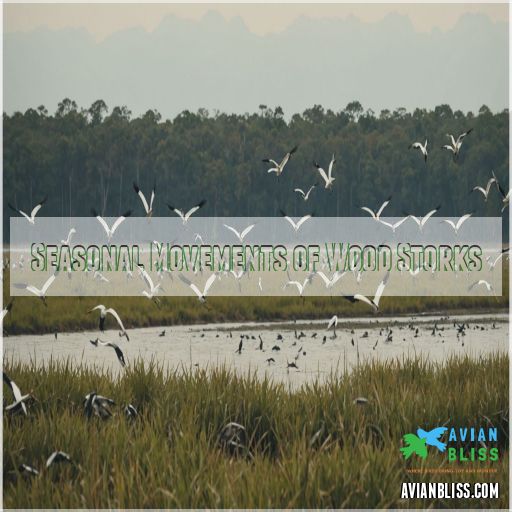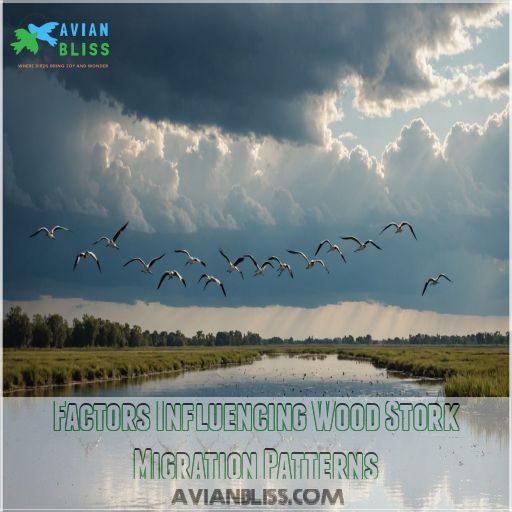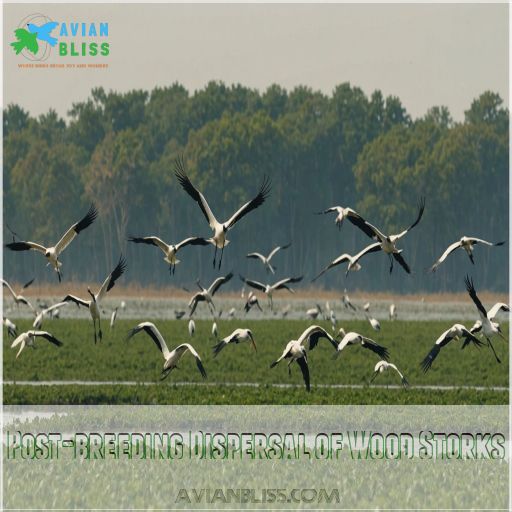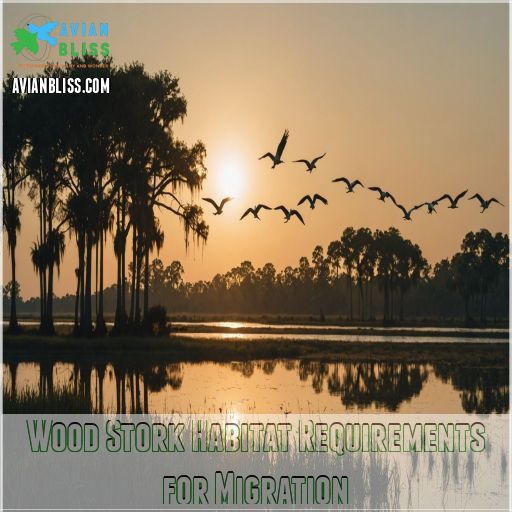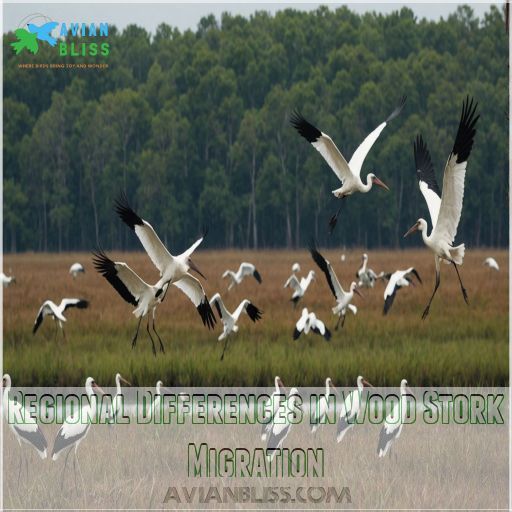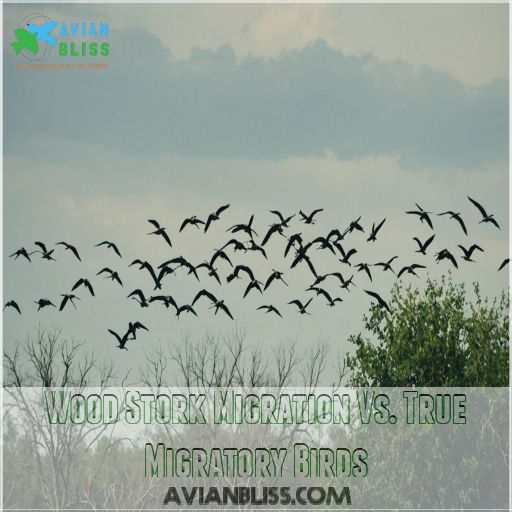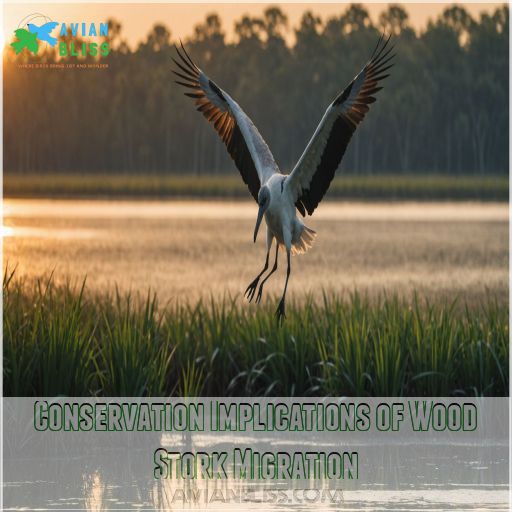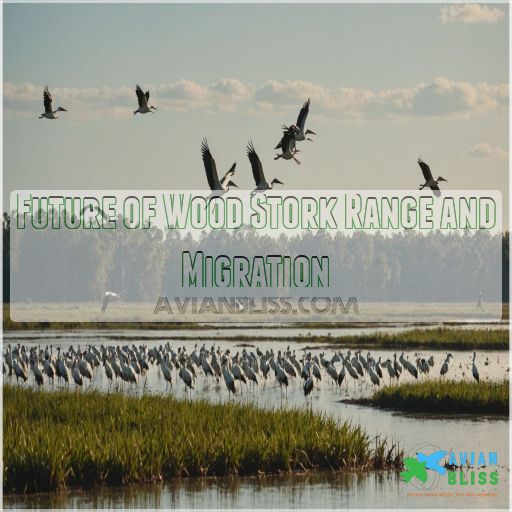This site is supported by our readers. We may earn a commission, at no cost to you, if you purchase through links.

While not true migrants, wood storks perform impressive regional movements driven by rainfall and food availability. They’re the ultimate weather watchers, following the ebb and flow of wetlands to find prime fishing spots.
From Florida’s cypress swamps to Amazonian floodplains, these adaptable birds are always on the move. Their unique "tactile hunting" technique lets them thrive in various shallow waters.
But life’s not always a walk in the park – habitat loss and climate change are throwing curveballs at their traditional stomping grounds.
Table Of Contents
- Key Takeaways
- Wood Stork Range: North and South America
- Seasonal Movements of Wood Storks
- Factors Influencing Wood Stork Migration Patterns
- Post-breeding Dispersal of Wood Storks
- Wood Stork Habitat Requirements for Migration
- Regional Differences in Wood Stork Migration
- Wood Stork Migration Vs. True Migratory Birds
- Tracking Wood Stork Movements and Migration
- Conservation Implications of Wood Stork Migration
- Future of Wood Stork Range and Migration
- Frequently Asked Questions (FAQs)
- Do wood storks migrate?
- Is a wood stork a migratory bird?
- Where do wood storks breed?
- Do wood storks stay in the south?
- Where do wood storks go in the winter?
- What is the migration pattern of storks?
- Where do woodstorks go in the summer?
- What is the migration of the stork?
- How fast can wood storks fly during migration?
- Do wood storks migrate in large flocks or individually?
- Can wood storks interbreed with other stork species?
- How do climate changes affect wood stork migration patterns?
- Are there any cultural or historical significances of wood stork migration?
- Conclusion
Key Takeaways
- You’ll be surprised to learn that wood storks aren’t your typical snowbirds—they’re partial migrants that cover an impressive 70 degrees of latitude, from South Carolina to South America. These quirky waders are like feathered weather watchers, following the ebb and flow of wetlands to find prime fishing spots.
- Don’t be fooled by their gangly appearance—wood storks are masters of adaptation. You’ll find them making themselves at home in diverse habitats, from Florida’s cypress swamps to Amazonian floodplains. Their unique "tactile hunting" technique lets them thrive in various shallow waters, making them the ultimate wetland wanderers.
- Climate change is throwing wood storks a curveball, but they’re rising to the challenge. You’ll see these resilient birds expanding their breeding range northward and even becoming year-round residents in some areas. It’s like they’re playing a high-stakes game of woodpecker winter adaptations, adapting their migration patterns to our changing world
.
- You can play a part in wood stork conservation! By supporting wetland protection and participating in citizen science projects related to water birds in Illinois, you’re helping these iconic birds navigate the challenges of habitat loss and climate change
. It’s like being part of a global "neighborhood watch" for our long-legged friends, ensuring they can continue their impressive journeys for generations to come.
Wood Stork Range: North and South America
You might think wood storks stick to the swamps of Florida, but these lanky waders have quite the range.
From the coastal wetlands of South Carolina to the lowlands of South America, wood storks roam an impressive stretch of the Americas.
Making surprising seasonal treks that’ll have you rethinking what you know about these iconic birds.
Latitude Range From 35° North to 35° South
You might be surprised to learn that wood storks are true globetrotters.
These iconic waders spread their wings across a vast swath of the Americas, from 35° north to 35° south latitude. That’s quite a range!
Whether you’re in the southern United States or the heart of South America, you could spot these distinctive birds.
Their wide distribution showcases their adaptability to various climates and habitats across two continents.
Lowland Regions Below 980 Feet Elevation
Wood storks don’t just stick to sea-level habitats. These impressive waders thrive in lowland regions below 980 feet elevation.
You’ll find them wading through shallow waters, from coastal marsh habitats to inland wetlands
. Their unique feeding technique, tactolocation, works best in these low-lying areas where water levels fluctuate seasonally.
It’s like they’ve got a built-in fish finder that’s perfectly tuned to these ecosystems!
Coastal Areas and Inland Wetlands
As you explore the wood stork’s world, you’ll find these majestic birds making themselves at home in both coastal areas and inland wetlands. Their adaptability is truly impressive! From salt marshes teeming with life to freshwater swamps, these habitats offer a smorgasbord of dining options for our long-legged friends.
Let’s take a peek at some key features of their wetland homes:
- Shallow waters for easy foraging
- Abundant fish and invertebrate populations
- Varied vegetation for nesting and roosting
- Tidal creeks and oyster reefs
- Protected areas away from human disturbance
Stronghold in Peninsular Florida
Peninsular Florida‘s the heart of wood stork habitats, a real hotspot for these iconic waders
. You’ll find their largest colonies here, with some nesting sites boasting a jaw-dropping 5,000 to 10,000 pairs . But it’s not all sunshine and swamps for our feathered friends.
Let’s break down their situation:
| Aspect | Challenge | Impact |
|---|---|---|
| Habitat | Loss due to development | Fewer nesting sites |
| Water | Management changes | Altered feeding grounds |
| Population | Declined since 1930s | Now endangered |
| Conservation | Ongoing efforts | Slow but steady recovery |
Populations in Southeastern United States
Beyond Florida’s borders, you’ll find wood storks spreading their wings across the Southeast.
These gangly waders have expanded their range, now calling Georgia, South Carolina, and even coastal North Carolina home . It’s like they’ve decided to go on a road trip, setting up nesting colonies in new neighborhoods.
Despite facing challenges like habitat loss, these resilient birds are adapting and even thriving in some areas, thanks to conservation efforts.
Distribution in Central and South America
You’ll find wood storks spread across Central and South America, where they’ve made themselves at home in diverse habitats. These adaptable birds avoid the towering Andes and bone-dry Atacama Desert, preferring lowland areas teeming with aquatic life (Source).
- Coastal wetlands along both Atlantic and Pacific shores
- Lush river basins like the Amazon and Orinoco
- Seasonally flooded savannas in Brazil and Venezuela
Their distribution hinges on one key factor: food availability.
Seasonal Movements of Wood Storks
Wood storks aren’t your typical snowbirds. These iconic waders have a knack for keeping us guessing with their seasonal movements.
You might think they’d follow a strict north-south pattern, but these birds march to the beat of their own drum. Some wood storks stick around their breeding grounds year-round, while others set out on surprising journeys.
They’ll take flight in search of greener pastures – or rather, wetter wetlands – when local conditions don’t suit their fancy. It’s like they’re playing a game of "musical marshes", always on the lookout for the perfect spot to call home.
Factors Influencing Wood Stork Migration Patterns
You might think wood storks follow a simple migration pattern, but their movements are surprisingly complex.
These iconic waders respond to a variety of factors that influence when and where they travel, making their journeys a fascinating puzzle for scientists to unravel.
Food Availability and Water Levels
The delicate dance of water and food drives wood stork migrations. You’ll find these iconic waders following the ebb and flow of wetlands, their movements intricately tied to water levels and prey abundance.
As wetlands dry up, fish concentrate in shallow pools, creating a buffet for hungry storks .
But it’s a tricky balance – too much water spreads fish out, while drought leaves storks high and dry, impacting breeding success.
Rainfall Patterns and Seasonal Changes
Rainfall patterns and seasonal changes play a starring role in the wood stork’s migration drama. You’d be amazed at how these birds respond to Mother Nature’s whims.
- Dry spells concentrate fish in shrinking pools
- Heavy rains can flood nesting sites
- Seasonal shifts trigger food availability changes
- Water level fluctuations influence foraging success
Just like you might pack an umbrella for a rainy day, wood storks adjust their travel plans based on these watery cues.
Breeding Cycle and Post-breeding Dispersal
Driven by an innate rhythm, wood storks’ breeding cycle profoundly influences their migration patterns.
You’ll find these iconic waders nesting in colonies, constructing large stick nests in swamps or on islands.
After breeding, they set off on a remarkable journey known as post-breeding dispersal.
This phenomenon sees storks from the southeastern U.S. temporarily moving into Alabama and eastern Mississippi, while others, likely from Mexico or Central America, flock to the lower Mississippi River Valley, illustrating their remarkable journey.
Habitat Loss and Human Disturbances
You’d think wood storks would have it easy, but they’re facing some serious challenges.
As humans expand their footprint, these iconic waders are feeling the squeeze. Wetland drainage and agricultural expansion are gobbling up prime real estate.
It’s like someone’s playing Monopoly with their homes! Urban sprawl and pollution aren’t doing them any favors either.
These disturbances are forcing wood storks to rethink their traditional migration routes and nesting spots.
Climate Change Impacts on Movement
Climate change is shaking up the Wood Stork’s world.
As temperatures rise and weather patterns shift, these iconic waders are facing new challenges. You might think they’d just flap their wings and adapt, but it’s not that simple.
Changes in rainfall and water levels are altering their wetland habitats, potentially throwing a wrench in their food supply and breeding grounds. It’s like nature’s playing a game of musical chairs with their homes.
Post-breeding Dispersal of Wood Storks
You might think wood storks are homebodies, but these big birds love a good post-breeding road trip.
After raising their chicks, wood storks set off on surprising journeys that’ll make you rethink what you know about these iconic waders.
Northward Movement From Florida Colonies
Florida’s wood storks set off on a surprising journey after breeding season.
You’ll find these iconic waders spreading their wings and heading north, following the promise of better foraging grounds.
As water levels drop and prey concentrates in shrinking pools, these savvy birds take to the skies, sometimes abandoning their nests in search of greener pastures.
It’s nature’s way of ensuring survival in a changing landscape.
Westward and Northward Dispersal From North Florida
Uncovering the secrets of wood stork dispersal from North Florida reveals a fascinating pattern.
After breeding, these iconic waders don’t just head north – they fan out westward too.
You’ll find them venturing into Alabama, seeking out new food sources as they go.
It’s like they’re on a road trip, exploring the Southeast’s buffet of wetlands.
Climate change might be shaking up their usual routes, keeping researchers on their toes due to this Climate change.
Southern and Western Movement From Georgia Colonies
While Georgia’s wood storks often stick close to home, some set off on surprising journeys after breeding.
You’ll find these lanky waders heading south or west, seeking greener pastures – or rather, wetter wetlands.
Their wanderlust isn’t random; it’s all about following the food.
As water levels drop and fish become scarce, these savvy storks pack their bags and hit the road, adapting to nature’s ever-changing buffet, driven by their need to find new sources of food in response to wetter wetlands and nature’s ever-changing buffet.
Juvenile Dispersal Patterns
You’ll be amazed by the wanderlust of young wood storks! After fledging, these adventurous juveniles often set off on northward journeys, exploring new territories beyond their birthplace.
They’re not just following their parents’ flight paths – these youngsters are true trailblazers.
Environmental factors like rainfall and food availability guide their travels, shaping their survival rates and habitat choices. It’s nature’s way of ensuring the species’ adaptability and resilience.
Wood Stork Habitat Requirements for Migration
You might think wood storks are picky travelers, but these adaptable birds have surprisingly flexible habitat needs for their journeys, particularly in marsh ecosystems with long-legged waders like wading birds
.
From freshwater wetlands to coastal mangroves, wood storks make use of a variety of watery pit stops as they wander across their range, which showcases their ability to thrive in different environments, such as coastal mangroves.
Freshwater and Saltwater Wetlands
Moving through a mosaic of wetlands, wood storks rely on both freshwater and saltwater habitats for their survival.
You’ll find these iconic waders foraging in shallow marshes, where falling water levels concentrate their fishy prey.
From cypress swamps to mangrove forests, these adaptable birds thrive in diverse ecosystems.
As wetland conservation becomes increasingly important, protecting these habitats isn’t just for the storks—it’s a lifeline for countless species and a buffer against climate change .
Lakes, Ponds, and River Systems
Lakes, ponds, and river systems form a key lifeline for wood storks during their migration. These aquatic havens offer a buffet of delights for our long-legged friends:
- Shallow waters teeming with fish
- Mudflats rich in crayfish and insects
- Quiet backwaters perfect for wading
- Diverse ecosystems supporting a smorgasbord of prey
Wood storks utilize a unique "tactile" method to catch their prey in these environments, snapping their bills shut when prey touches them, similar to their foraging behavior in southeastern swamps. With their adaptability, they’re not picky eaters, snatching up everything from minnows to baby alligators!
You’ll find these resourceful birds foraging in freshwater marshes, flooded fields, and even ditches. They’re not picky eaters, snatching up everything from minnows to baby alligators!
Cypress Swamps and Mangrove Forests
Cypress swamps and mangrove forests are the wood stork’s go-to hangouts during migration.
These unique ecosystems offer a smorgasbord of fish and aquatic invertebrates, perfect for a hungry stork.
You’ll find these leggy birds nesting in cypress trees above standing water or setting up shop in mangroves along the coast.
It’s like they’ve found the ultimate bed and breakfast – a cozy place to rest with an all-you-can-eat buffet right outside!
Flooded Impoundments and Shallow Waters
Wading through flooded impoundments and shallow waters, you’ll find wood storks in their element.
These iconic birds thrive in habitats where:
- Water depths range from 4-12 inches
- Falling water levels concentrate prey
- Seasonal flooding creates food-rich pools
- Diverse wetlands offer foraging options
You’ll spot these clever waders stirring up fish with their feet or slowly sweeping their bills through the water – nature’s own "fish finders" at work!
Regional Differences in Wood Stork Migration
You might think wood storks stick to one area, but these birds have some surprising travel habits.
From Florida’s northward wanderers to Mexico’s coastal cruisers, wood storks across the Americas show fascinating regional differences in their migration patterns.
Florida Population Movements
You’d be amazed at how Florida’s Wood Storks keep everyone on their toes!
These savvy birds have adapted their movements to South Florida’s altered hydrology. They’re not your typical snowbirds – their travel plans depend on what Mother Nature’s cooking up.
Breeding grounds shift with the ebb and flow of water levels, and hurricanes play a big role in their decision-making process. Food availability also plays a significant part in their choices.
It’s like they’re playing a high-stakes game of musical nests!
Georgia and South Carolina Stork Patterns
Georgia and South Carolina’s wood storks march to the beat of a different drum compared to their Florida cousins. These northern nesters aren’t homebodies – they’re seasonal snowbirds!
- Winter exodus: Most storks fly south for the winter
- Florida-bound: Many head to South Florida’s warmer climes
- Short-distance movers: Some settle in North and Central Florida
- Early birds: A few hardy souls stick around through winter
Mexican Population Summer Dispersal
While Georgia and South Carolina storks have their own patterns, Mexican Wood Storks dance to a different tune.
You’ll find these wanderers making surprising summer trips. They’ve been spotted in the lower Mississippi River Valley, Louisiana, and Texas during late summer and fall.
It’s like they’re on a culinary tour, seeking out the best feeding spots. The Salton Sea and Texas coast become hotspots for these feathered foodies, adapting to changing food sources and climate conditions, as they search for the best feeding spots.
South American Wood Stork Movements
In South America, Wood Storks dance to a different tune. Their movements are as diverse as the continent’s landscapes:
- Andean foothills serve as breeding grounds
- Coastal wetlands become key stopover sites
- Amazonian floodplains offer year-round habitat
You’ll find these iconic waders adapting to everything from lush rainforests to arid coastlines. However, they’re conspicuously absent from the Atacama Desert – even these versatile birds have their limits!
Food availability and seasonal rainfall patterns play a starring role in their South American journeys.
Wood Stork Migration Vs. True Migratory Birds
You might think all birds that move seasonally are true migrants, but wood storks challenge this notion.
Their movements, driven by food availability rather than strict seasonal patterns, set them apart from long-distance migrants.
While still earning them protection under the Migratory Bird Treaty Act.
Classification Under Migratory Bird Treaty Act
Many folks assume wood storks are true migratory birds, but their classification under the Migratory Bird Treaty Act isn’t so straightforward. Let’s take a closer look at how these iconic waders fit into the legal framework:
| Aspect | Wood Storks | Typical MBTA Species |
|---|---|---|
| Protection | Threatened | Fully protected |
| Movement | Irregular | Typical migratory patterns |
| Range | Expanding | Often stable |
| Delisting | Proposed | Rare occurrence |
You’ll find wood storks behaving differently than other birds in terms of migration.
Comparison With Long-distance Migrants
Unlike their long-distance cousins, Wood Storks aren’t your typical snowbirds. You won’t find them zipping across continents like some feathered frequent flyers. Instead, these wetland wanderers take a more laid-back approach to travel.
Let’s break down how they compare to the marathon migrants:
- Shorter trips: Wood Storks stick closer to home
- Flexible schedules: They’re not slaves to the calendar
- Wetland hopscotch: They jump between watery pit stops
Their unique travel style makes them stand out in the bird world, just like that one friend who always takes the scenic route.
Flexibility in Movement Patterns
Wood storks’ migration journey is a dance of flexibility, adapting to nature’s ever-changing tune.
You’ll find these savvy birds adjusting their movements based on a variety of factors:
| Factor | Impact on Movement |
|---|---|
| Food availability | Drives foraging patterns |
| Water levels | Influences nesting sites |
| Breeding cycle | Dictates seasonal shifts |
| Habitat change | Forces new routes |
| Climate change | Alters timing and range |
Unlike clockwork migrants, wood storks play it by ear, their wanderings a reflection of their resilience in unpredictable wetland habitats.
Year-round Residents Vs. Seasonal Movers
You might think all wood storks follow the same playbook, but these quirky birds keep us guessing!
While some storks are homebodies, sticking around their favorite wetlands year-round, others embrace their inner wanderlust .
It’s like they’re playing a game of "musical swamps", moving with the rhythm of changing water levels and food availability.
Climate change is shaking up their routines, making each stork’s journey a unique adventure.
Tracking Wood Stork Movements and Migration
You might think tracking a giant white bird would be easy, but wood storks are surprisingly elusive travelers.
Scientists use a variety of clever methods to keep tabs on these iconic waders, from high-tech satellite trackers to old-school bird banding and even enlisting the help of eagle-eyed birdwatchers.
Satellite Tracking Technologies
Satellite tracking has revolutionized our understanding of Wood Stork movements.
These high-tech devices have allowed researchers to create a detailed picture of annual individual movements in wading birds across the US.
You’ll be amazed at the precision with which scientists can now follow these majestic creatures.
It’s like having a bird’s-eye view of their journeys, revealing surprising patterns and behaviors that were previously hidden from us.
These discoveries are shedding new light on the secrets of these amazing birds.
Banding and Recovery Studies
Ever wondered how scientists track these majestic waders?
Banding and recovery studies offer a window into the secret lives of wood storks. Here’s what you need to know:
- Researchers attach unique bands to storks’ legs
- When banded birds are spotted or recovered, data is reported
- Analysis reveals migration patterns and survival rates like those of fruit and insect eaters
These studies have helped expand our understanding of wood stork breeding ranges, showing significant growth from the 1970s to 2019.
Citizen Science Observations
Citizen scientists have stepped up to the plate in tracking wood stork movements. Your observations can make a world of difference in understanding these iconic waders.
| Project | What to Look For | How to Report |
|---|---|---|
| SCDNR Wading Bird Program | Banded storks | Email [email protected] |
| Bird Banding Lab | Tagged birds | Call 1-800-327-BAND |
| eBird | Wood stork sightings | Submit via eBird platform |
| Local Audubon Chapters | Colony locations | Contact chapter directly |
| iNaturalist | Wood stork photos | Upload to iNaturalist app |
Remote Sensing for Habitat Monitoring
Remote sensing takes bird tracking to new heights! You’ll be amazed at how researchers use satellite imagery to keep tabs on wood stork habitats. It’s like having a bird’s-eye view of their favorite hangouts.
This tech isn’t just for the pros – you can get in on the action too!
- Spot wetland changes from your couch
- Track forest health like a pro
- Become a habitat detective with satellite maps
Researchers are using high-resolution satellite data to map everything from flamingo congregations to penguin nesting sites. It’s a game-changer for understanding how these majestic birds use their environment.
Conservation Implications of Wood Stork Migration
You might think wood storks just wander around aimlessly, but their movements have big implications for conservation.
Understanding their migration patterns like those of flamingos is essential for protecting these unique birds and the wetland habitats they depend on across North and South America
.
Protecting Critical Stopover Sites
While wood storks may not win any beauty contests, their survival hinges on protecting important pit stops along their journey.
You’ll find these iconic waders resting and refueling at wetlands, cypress swamps, and mangroves. By safeguarding these key habitats through habitat restoration and conservation partnerships, you’re not just helping storks – you’re preserving entire ecosystems.
Get involved in citizen science efforts to monitor these sites and raise public awareness about their importance. Every action counts in keeping these quirky birds soaring!
Maintaining Water Flow in Key Habitats
You’ve seen how important stopover sites are for wood storks.
Now, let’s talk water flow. It’s the lifeblood of their habitat.
Think of the Everglades as a giant bathtub – when we mess with the taps, storks suffer.
Altered water levels make it tough for these big birds to find fish during nesting season .
By restoring natural flows, we’re not just helping storks – we’re giving the whole ecosystem a fighting chance against climate change.
Cross-border Conservation Efforts
Wood storks don’t stop at borders, and neither should our conservation efforts.
You’ll be amazed at how these lanky birds bring countries together. From the U.S. to Mexico, binational partnerships are taking flight to protect key habitats.
The North American Wetlands Conservation Act is a real game-changer, providing matching grants for projects that benefit migratory birds across the continent . It’s like a passport program for our feathered friends, supporting conservation efforts that know no borders through binational partnerships.
Climate Change Adaptation Strategies
With climate change looming, wood storks need our help to adapt.
You’re part of the solution! By supporting water management and habitat restoration efforts, you’ll boost these iconic waders’ food security .
Keep an eye out for citizen science opportunities in population monitoring – it’s a great way to contribute while enjoying nature.
Climate modeling helps predict future challenges, ensuring we’re always one step ahead in protecting these remarkable birds.
Future of Wood Stork Range and Migration
You might think wood storks have their migration patterns all figured out, but the future holds some surprises for these iconic waders.
As climate change and habitat loss reshape their world, wood storks are poised for some big shifts in where they breed, when they move, and how they adapt to our ever-changing landscape.
They are going to have to adapt to their new and changing world.
Predicted Shifts in Breeding Range
As conservation efforts shape the future of wood storks, their breeding range is expected to shift. Climate change impacts and habitat loss effects are pushing these iconic waders to adapt.
You’ll likely see them expanding northward, seeking new nesting grounds. Here’s what to watch for:
- More colonies popping up in North Carolina
- Increased nesting in inland wetlands
- Fewer breeding pairs in traditional South Florida strongholds
- Surprising appearances in unexpected locations
These changes reflect the storks’ resilience in the face of environmental challenges .
Potential Changes in Migration Timing
You’ve probably noticed that birds’ schedules seem a bit off lately. Well, Wood Storks are feeling it too! Their migration timing‘s getting a shake-up, thanks to our changing climate.
Let’s take a peek at what’s causing these feathered friends to switch up their travel plans:
| Factor | Impact | Trend |
|---|---|---|
| Temperature | Earlier breeding | Increasing |
| Rainfall | Altered wetland conditions | Unpredictable |
| Food availability | Shifts in prey patterns | Decreasing |
| Human activity | Habitat disruption | Growing |
These changes could mean big adjustments for our lanky-legged pals.
Adaptability to Altered Landscapes
Wood Storks are adapting to our changing world with surprising resilience.
You’ll find these iconic waders adjusting to habitat fragmentation and altered water flows caused by human impact. They’re even exploring novel food sources near urban areas, though this shift comes with potential downsides, such as altered shelter options, like seeking refuge in dense native shrubs, to find food and protection.
As they navigate these changes, they’re also learning to adapt their behavior, such as dealing with windy and rainy weather.
As landscapes transform, Wood Storks demonstrate remarkable climate resilience, but their adaptability raises questions about their future role as wetland health indicators.
Long-term Population Trends and Distribution
The long-term outlook for wood storks is a tale of resilience and adaptation.
You’ll be heartened to know that their population has rebounded from a low of 4,000-5,000 nesting pairs in 1984 to over 10,000 pairs since 2016.
Despite facing challenges like habitat loss and climate change, these iconic waders have shown remarkable adaptability, expanding their breeding range and exploiting new wetland habitats.
It’s a strong indication of their tenacity and the effectiveness of conservation efforts.
Frequently Asked Questions (FAQs)
Do wood storks migrate?
Yes, wood storks are partially migratory.
They’ve adapted their movements in response to environmental changes, with some becoming year-round residents.
Their migration patterns are complex, varying based on local conditions and individual preferences.
Is a wood stork a migratory bird?
Surprisingly, wood storks are partially migratory birds.
You’ll find some sticking around their breeding grounds year-round, while others head out on seasonal journeys.
Their migration patterns are flexible, adapting to environmental conditions like wetland health and food availability.
Where do wood storks breed?
You’ll find wood storks breeding in coastal wetlands of Florida, Georgia, and South Carolina.
They’ve expanded their range north in recent years, now nesting in cypress swamps and mangroves from Florida to North Carolina.
Do wood storks stay in the south?
Like feathered nomads on a wetland walkabout, wood storks don’t always stay put in the South.
They’re partially migratory, wandering widely in response to local conditions.
Some stick around year-round, while others take flight for greener pastures.
Where do wood storks go in the winter?
Wood storks from Georgia, South Carolina, and coastal North Carolina head to South Florida in winter.
They’re not strictly migratory, but make regional moves based on food availability.
Some birds settle in North Florida and Central Florida too.
What is the migration pattern of storks?
Storks exhibit partial migration patterns, with some individuals staying put while others travel.
You’ll find these adaptable birds shifting their strategies based on environmental changes and food availability.
Their movements reflect the health of wetland ecosystems they inhabit.
Where do woodstorks go in the summer?
You’ll find these majestic birds spreading their wings across the southeastern United States in summer.
They’ll nest in coastal areas of Florida, Georgia, and South Carolina, forming bustling colonies in cypress swamps and mangroves.
After breeding, they disperse northward for foraging adventures.
What is the migration of the stork?
Like a maestro conducting nature’s symphony, these majestic birds orchestrate their movements.
You’ll find Wood Storks partially migrating, responding to environmental changes.
They’re not traditional migrants but wander widely, adapting their patterns based on local wetland conditions.
How fast can wood storks fly during migration?
During migration, these graceful flyers can cruise at impressive speeds.
While exact figures aren’t provided, you’ll find wood storks soaring effortlessly on thermals, often alongside vultures and raptors, covering long distances with minimal energy expenditure (Source).
Do wood storks migrate in large flocks or individually?
Wood storks, with their impressive 5’6" wingspan, typically migrate in flocks.
You’ll spot these social birds soaring high on warm air currents, creating a breathtaking spectacle as they journey together to their seasonal destinations.
Can wood storks interbreed with other stork species?
While there’s no direct evidence of wood storks interbreeding with other species.
You’ll find that hybridization can be a threat to some stork populations. For instance, milky storks have been crossbreeding with painted storks, endangering their genetic purity.
How do climate changes affect wood stork migration patterns?
You might think climate doesn’t affect storks much, but you’d be surprised.
Climate changes are causing Wood Storks to alter their migration patterns.
They’re expanding northward and some are becoming year-round residents, relying more on human food sources.
Are there any cultural or historical significances of wood stork migration?
These majestic birds play a significant role in local cultures.
You’ll find them symbolizing good fortune in Alsatian folklore.
In South Carolina, they’re celebrated with annual events like "Storks and Corks" (Source), showcasing their cultural importance.
Conclusion
You’ve just scratched the surface of the wood stork’s incredible range migration! These feathered frequent flyers cover more ground than most humans do in a lifetime.
As you’ve learned, their journeys aren’t just aimless wandering – they’re carefully orchestrated dances with weather patterns and weather availability.
Next time you spot a wood stork, remember: you’re witnessing a master of adaptation in action.
With continued conservation efforts, we can help these iconic waders keep surprising us with their remarkable journeys for generations to come.


